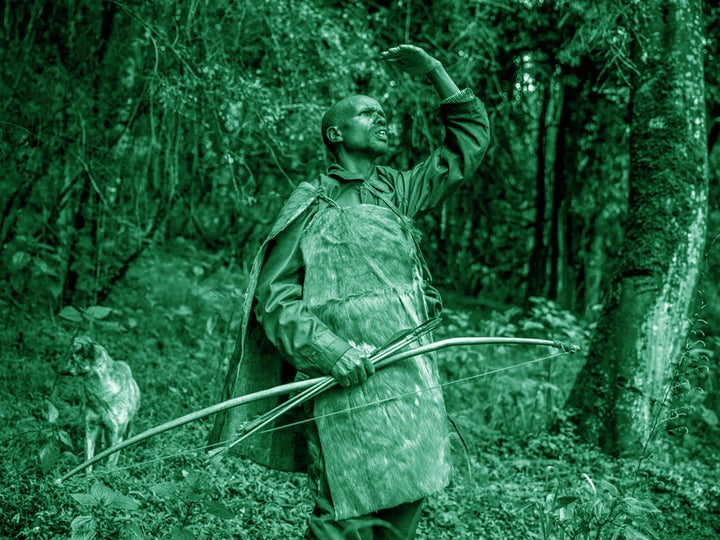How and why are indigenous people are on the front line of the climate crisis?
- Why are indigenous people so badly affected?
- Which indigenous peoples are affected by climate change?
- What actions are they taking?

Indigenous people throughout the world are disproportionately affected by the climate crisis, even when it comes to climate-related violence.
A record number of activists working to protect the environment and land rights were murdered last year.
227 people were killed around the world in 2020, the highest number recorded for a second consecutive year, according to a report by campaign group Global Witness.
Environmental defenders from indigenous groups had the largest number of deaths, with most violence occurring in Central and South America. Almost a third of the murders were reportedly linked to resource exploitation - logging, mining, large-scale agribusiness, hydroelectric dams and other infrastructure.
A senior campaigner for Global Witness, Chris Madden, said: “This dataset is another stark reminder that fighting the climate crisis carries an unbearably heavy burden for some, who risk their lives to save the forests, rivers and biospheres that are essential to counteract unsustainable global warming. This must stop.”
Why are indigenous people so badly affected?
According to the UN’s Department of Economic and Social Affairs, indigenous peoples are among the first to face the direct consequences of climate change, due to their dependence upon, and close relationship, with the environment and its resources.
The problems created by climate change, such as land degradation and deforestation, exacerbate the difficulties already faced by indigenous communities – political and economic marginalisation, loss of land and resources, human rights violations, discrimination, and unemployment.
Climate change poses threats and dangers to the survival of indigenous communities worldwide, even though indigenous peoples contribute the least to greenhouse emissions.
In fact, the UN states, indigenous peoples are a vital part of the many ecosystems that inhabit their lands and territories and may therefore help enhance the resilience of these ecosystems.
In addition, indigenous peoples interpret and react to the impacts of climate change in creative ways, drawing on traditional knowledge and other technologies to find solutions that may help society at large to cope with impending changes.
For example in Bangladesh, villagers are creating floating vegetable gardens to protect their livelihoods from flooding, while in Vietnam, communities are helping to plant dense mangroves along the coast to diffuse tropical-storm waves.
Which indigenous peoples are affected by climate change?
Communities throughout the world are seeing their health and livelihoods destroyed by floods, drought, deforestation and a host of other calamities wrought by environmental degradation.
For example, more than 35 million people live in the Amazon, including almost three million indigenous peoples from over 350 indigenous groups. They have lived in the Amazon for millennia but face the destruction of their forest home due to illegal deforestation, habitat conversion, and the resulting fires.
Awapy Uru-eu-wau-wau, a cacique (chief) of the Uru-eu-wau-wau indigenous people, heads up surveillance of the Uru-eu-wau-wau indigenous land in Rondônia, Brazil, recording land invasions and illegal deforestation. He and his family have received death threats as they attempt to protect their home from armed invaders.
He said: “Nature is important to me because I was born in the jungle, I grew up in the jungle, and my father taught me how to deal with nature,” he says.
“Nature, for us, is the life of us indigenous peoples. Why? It gives pure oxygen, it gives natural food to us, hunting, fishing, native fruits of the jungle, medicine – so, it is important to us, because we live off the jungle.”
Another example is the Majhis, one of the indigenous peoples of Nepal, of Bodgaun village, in Sindhupalchowk district. They were profoundly impacted by the 2015 Nepal earthquake and as they struggled to rebuild were confronted with numerous challenges related to climate.
Their crops are being devasated by both extreme drought and extreme rainfall in a village where 85.5% of the community gained their income from agriculture and animal husbandry.
What actions are they taking?
Many indigenous groups have implemented innovative solutions to the problems they face.
Writing in Nature, Linda Etchart of the University of London, wrote: “Until the twenty-first century, indigenous peoples were viewed as victims of the effects of climate change, rather than as agents of environmental conservation.
“Representatives of indigenous peoples have in fact been actively seeking a role in contributing to combating climate change through their participation in international environmental conferences, as well as by means of activism and political engagement at local and national levels.”
One interesting example is Hinduo Oumarou Ibrahim, an indigenous advocate and geographer from Chad, founder of the Association for Indigenous Women and Peoples of Chad (AFPAT), and co-chair of the International Indigenous Peoples Forum on Climate Change.
She told COP26 attendees: “We, indigenous peoples, have a PhD in reforestation and sustainable management of land.”
“In the Sahel, my people are the best architects of the Great Green Wall that avoids desertification and restores land degradation.
“We do this as a duty, not as a job. We use our Indigenous peoples’ traditional knowledge as a tool to protect nature. We don’t stand in front of you as a victim. No. Today, we stand as climate champions.”
Join our commenting forum
Join thought-provoking conversations, follow other Independent readers and see their replies
Comments
Bookmark popover
Removed from bookmarks